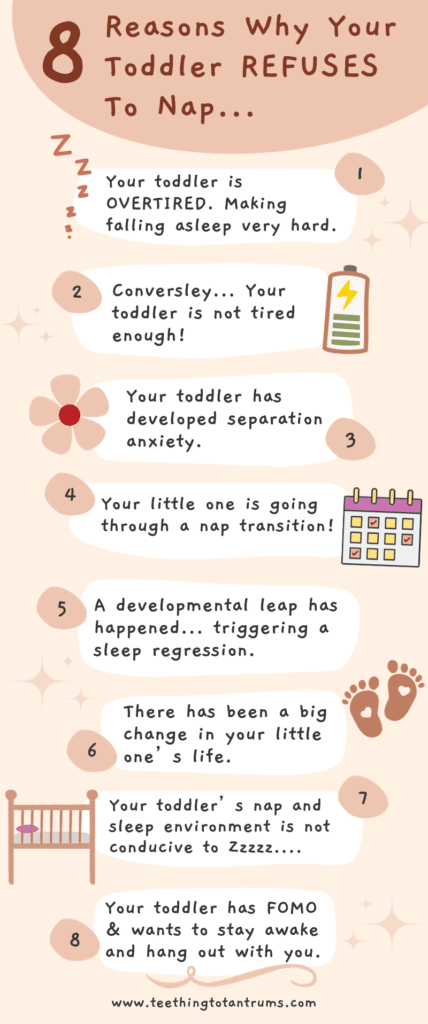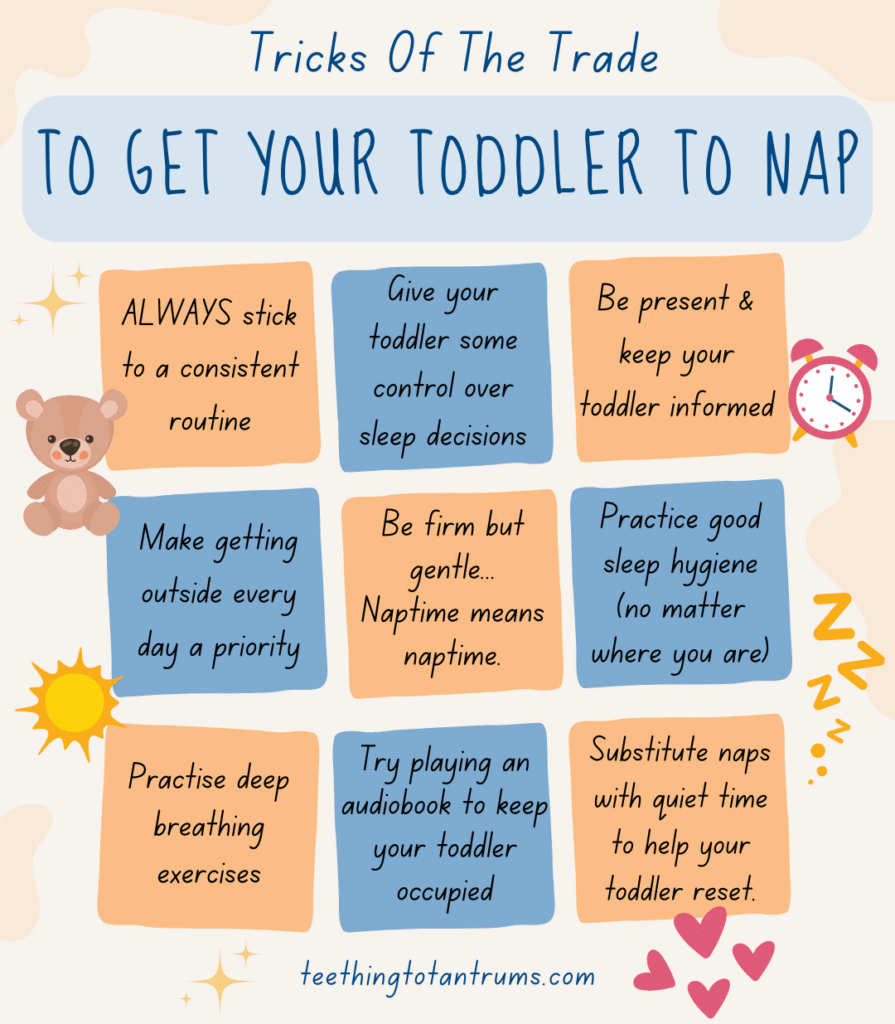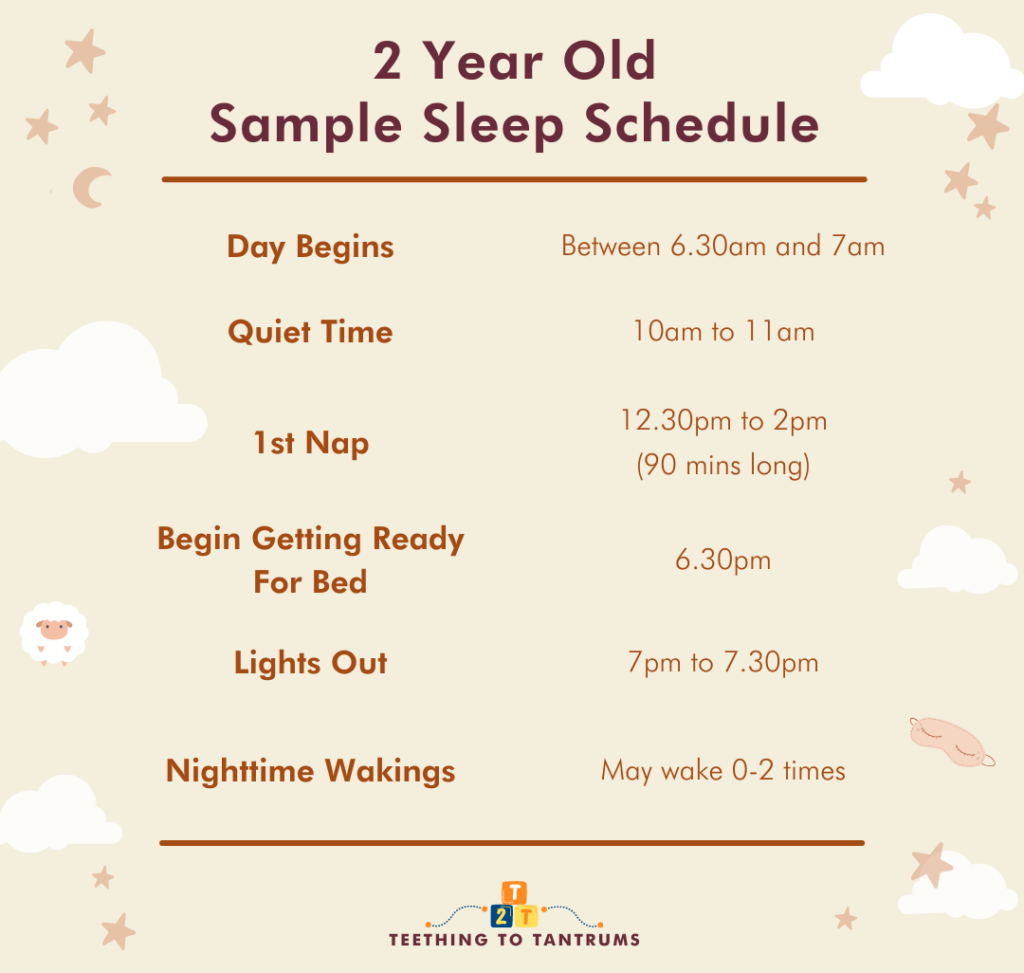After decades of working with toddlers, I understand how challenging and incredibly frustrating it can be to ensure your toddler gets the right amount of rest.
So in this article, I will cover the sleep needs of toddlers, the reasons why they resist napping, and my top effective strategies to encourage better daytime resting. With a consistent naptime routine and age-appropriate sleep hygiene, you can help your strong-willed toddler get the sleep they need to behave, focus, and develop! Let’s get started…

Table of Contents
Key Takeaways
- Most 2-year-olds need 11-14 hours of total sleep per day, including a 1.5 to 3-hour afternoon nap. Around 18-24 months, most transition from two naps to one daily nap.
- It’s normal for 2-year-olds to resist napping due to overtiredness, not being tired enough, separation anxiety, transitional phases, sleep regressions, life changes, poor sleep environments, and fear of missing out. Knowing how to get a 2-year-old to nap will be a
- To encourage better napping, have a consistent nap routine, give your toddler some control, and keep them informed of schedule changes. You can also encourage outdoor playtime, good sleep hygiene, deep breathing exercises, audio stories, and quiet time.
Understanding A 2-Year-Olds Sleep Needs
Most 2-year-olds need around 11-14 hours of sleep in 24 hours, with the bulk of their sleep being taken up with nighttime sleep and the rest taken with an afternoon nap that lasts from one and a half to three hours.
Younger toddlers will normally take two naps, but starting at about 18 to 24 months, most children will go through a nap transition and drop to one nap per day.
Is It Normal For A 2-Year-Old To Resist Napping?
Yes, it is normal for 2-year-olds to resist napping, especially as they become more independent and curious about the world around them.
However, some toddlers will resist napping because they are not tired enough which is a sure indicator that their sleep schedule needs adjusting, or they may just be going through a developmental stage where they want to assert their independence.
Looking to get your little one to sleep quickly and effortlessly? Check out my Bedtime and Nap Cheat Sheet and master the art of making daytime naps and bedtimes as seamless as possible.
A bedtime & nap cheat sheet so good your little one will ask you to put them to bed...
Laura Williams "This is a life saver! I'm so glad I downloaded your bedtime & nap cheat sheet. My little one actually asked me to put him to bed last night! Unbelievable! Thank you so much!"
Click Here For The FREE Cheat Sheet
Reasons Why Your Toddler Refuses To Nap
Naptime can often be a struggle for many parents and there are numerous reasons why your toddler may refuse to nap, including:

- Overtiredness: Despite the common myth, being overtired WILL NOT help your toddler to sleep. It has the opposite effect. Being overtired means your toddler’s body will release the hormones adrenaline and cortisol to help them stay awake. Which will make your toddler cranky and hyper instead of relaxed and calm.
- Not tired enough: If your toddler is ready to drop a nap they may resist being put down to sleep because they are not tired enough.
- Separation anxiety: It is common for toddlers to become anxious about being away from you or may need your presence to fall asleep. Leaving them at nap time could then become an issue.
- Nap transition: Your toddler may be transitioning from two naps to one, which can be a difficult adjustment for them to make.
- Sleep regression: Your toddler may be going through a sleep regression, which can cause disruptions in their sleep patterns both at night and during the day. A sleep regression usually happens around the same time as a big developmental leap.
- Changes in your toddler’s life: Changes in routine, environment, or family dynamics can also affect your toddler’s mood and nap schedule. These changes include starting daycare, moving house, or the arrival of a sibling.
- Different sleep environment: Your toddler’s sleep environment plays a vital role in helping them fall asleep. If it is not conducive to napping, such as too much noise or light, your toddler will not be able to fall asleep easily. Ensure their sleep space is dimly lit with a night light, at the correct temperature and if necessary use a white noise machine to help them settle.
- Fear Of Missing Out: Not wanting to miss out on exciting adventures is a very common cause of nap resistance. Your toddler is afraid of missing out on something fun so they would rather stay awake. It is our job as parents to engage in calming activities before nap time and if your toddler does resist sleeping or starts stalling, say you will be doing some very boring adult jobs whilst they sleep (such as emails, laundry, or cleaning).
Finding the right night light for your child can be quite a task. You want something safe, comforting, and practical. The Cozy Starry Night Light ticks these boxes, with eye-friendly warm lighting and an easy-to-use dimmer.
Its gentle glow makes it the best night light for feeding baby, diaper changes, or comforting your little one back to sleep.
As your baby grows the Cozy Starry Night Light's starry sky projection can provide comfort and gentle quiet time stimulation. Its soft lighting ensures a dreamy, peaceful environment, supporting your baby’s natural sleep cycle.
It really is a fantastic nightlight (at a very reasonable price!)
- Eye-friendly warm lighting with adjustable brightness.
- Includes a timer function for convenience.
- Projects a starry sky that is soothing for little ones.
- Rechargeable battery, so it's very portable.
- A USB adapter is not included for charging.
- The star projector is static without motion (however, this is ideal for very young babies and toddlers).
- Battery life varies based on the brightness settings.
Understanding the reasons behind your toddler’s refusal to nap can help you develop strategies to encourage them to rest.
How To Get A 2-Year-Old To Nap
I know from personal experience how frustrating it can be when the 2-year-old toddler in your care refuses to nap, especially when you know they need the rest.
However, it’s important to remember that nap refusal is a common issue for toddlers and that you may need to use various methods to persuade them to sleep when they need to.
Here are my top tips on how to handle toddler nap refusal:

1. Stick To A Routine
Establishing a consistent nap routine will help your toddler know what to expect and make it easier for them to fall asleep.
Try to stick to the same naptime every day and create a relaxing pre-nap routine, such as reading a book or singing a lullaby.
2. Give Your Toddler Some Control
Toddlers love to feel like they have some control over their lives. Their independence is flourishing and they want to use it!
Giving them two acceptable choices, such as choosing a nursery rhyme to sing, deciding which pajamas to wear, which soft toy to nap with, or which book to read, can help your toddler feel more comfortable and in control of the naptime routine.
3. Keep Your Toddler Informed
The lead-up to nap time is an activity transition. And as I am always saying… transitions need to be handled carefully for them to be peaceful and successful.
If your toddler is resisting naps then make sure that you are managing the pre-nap routine calmly and consistently and give your toddler ample warning that a naptime is coming up.
Stay with your toddler and help them finish their current activity before moving on to getting ready for their nap.
4. Get Outside Every Eay
Exposure to daylight will balance your toddler’s circadian rhythm. Therefore, your little one must get outside every day.
In conjunction with physical outdoor play, you can help your toddler sleep more soundly at night which will help establish a healthy nap time routine.
5. Be Firm But Gentle
It’s important to be firm about naptime, but also gentle with your toddler. Use a calm and reassuring tone of voice when it’s time to nap, and avoid getting frustrated or angry if your toddler resists.
Help your toddler understand that you will not give in to their demands and that naptime means naptime.
6. Practice Good Sleep Hygiene
Sleep hygiene is all about creating a good sleep environment can also help your toddler nap better.
Make sure the room is dark and quiet, and that your toddler is dressed appropriately for the room’s temperature. Consider using a white noise machine or blackout curtains to help your toddler sleep more deeply.
White noise machines are a game-changer for your little one's sleep and having one that plays all night is a must. With a long-lasting battery, this compact and stylish white noise machine contains 21 non-stop relaxing noises, which will lull your little one to sleep night after night, no matter where you are!
If your child is transitioning from a crib to a toddler bed, it’s important to create a space that feels safe and secure too. Make sure the bed is low to the ground and has guardrails to prevent falls.
You can also use a special blanket or stuffed animal to help your child feel more comfortable in their new bed.
7. Try Deep Breathing
Deep breathing is one of my favorite tips to help children relax. If your toddler struggles to wind down for nap time, encourage them to focus on some deep breathing to get them ready for sleep.
You can use online resources such as this deep-breathing exercise from Moshi Kids’ YouTube channel:
NOTE: MoshiKids has a downloadable app full of hundreds of hours of bedtime stories, sleep sounds, educational activities, songs, and white noise tracks. However, at $12.99 a month, it’s completely up to you whether you think it’s a worthwhile purchase. Whilst it has amazing reviews, you can find plenty of FREE resources on YouTube if you prefer!
8. Use Audio Stories
I always found that using audio stories was a great way to settle my son during the toddler years. This is because audiobooks give your little one something to focus on and will more often than not result in them falling asleep.
There are lots of free resources for children’s audiobooks and YouTube is best. I have also found the Dreams website contains a collection of fabulous bedtime stories, which you can access here: 9 Audio Bedtime Stories for Kids from Dreams
9. Consider Quiet Time
Quiet time is very important especially if your toddler refuses to nap or is going through a nap transition. To implement quiet time, leave your toddler with some quiet toys and toddler-appropriate books in their room and explain that it’s time to rest.
Although your child won’t feel as refreshed as if they had slept, having an hour or two of quiet play can help them reset ready for the rest of the day.
Plus, your toddler may fall asleep by themselves!
Sleep Schedule For A 2-Year-Old Toddler Who Does Not Nap
If your 2-year-old consistently refuses to nap during the day, it can be extremely challenging.
However, it’s essential to ensure that your toddler gets enough age-appropriate sleep in a day. Remember, most 2-year-olds need around 11-14 hours of sleep in 24 hours.
Without enough daytime sleep, your toddler will become overtired and cranky, which will make it harder for them to fall asleep at night.
Here are some tips for establishing a sleep schedule for a 2-year-old who consistently refuses to nap:
- Start the day early: Wake your toddler up at the same time every morning, ideally no later than 7 am. This will help to regulate their body clock and ensure that they are tired at bedtime.
- Adjust bedtime: With no nap, your toddler may need an earlier bedtime. Aim for a consistent bedtime between 6:30 pm and 7.30 pm. To ensure your toddler gets enough sleep to support their brain’s growth and development as well as their physical development, bedtime should be no later than 8 pm.
- Be consistent: Establish a consistent bedtime routine that includes calming activities such as a bath, storytime, and cuddling. This routine will signal to your toddler that it’s time to sleep.
- Create a sleep-conducive environment: As I mentioned earlier, ensure that your toddler’s sleep environment is quiet, dark, and cool. Use blackout curtains, a white noise machine, an audio story app, and comfortable sleepwear.
- Have a daily quiet time: If your toddler is refusing to sleep during the day then it is incredibly important that you implement a quiet time each day. This downtime will help your little one get through the day and prevent overtiredness.
- Teach your toddler to self-settle: Teaching your toddler to self-settle (or at the very least be happy to spend time alone) will help you establish a quiet time and hopefully a successful bedtime routine. Read this post about teaching your child to self-soothe to learn more.
- Give them a favorite toy or blanket to sleep with: Having a favorite soft toy or blanket to keep your toddler company when they fall asleep can often help them settle at both bedtime and nap time. Think back to your childhood… Did you have a blanket or teddy you simply couldn’t sleep without?
- Consider sleep training: If your toddler is really struggling to fall asleep, consider sleep training your toddler with techniques such as the Ferber method or the “I’ll be back method”. I do not recommend the cry-it-out method of toddler sleep training as I believe you can achieve great sleep success without leaving your child to cry. Please consult with your pediatrician before starting any sleep training program.
- Don’t give up: Finally, you should consistently offer your toddler opportunities to rest and sleep during the day. Sometimes their resistance is just a phase and will pass. With the right encouragement, at the very least, you will hopefully get your 2-year-old to rest during quiet times.
Sample 2-Year-Old Sleep Schedule
Here is a sample 2-year-old sleep schedule you can aim towards with your little one:

TOP TIP: I always suggest that the lead-up to bedtime starts after the last meal of the day and that you need to be fully engaged with your little one through the entire process. There should be no screen time in the two hours leading up to bedtime and all activities should be calming and low-key.
When to Seek Help About Toddler Naps
The American Academy of Pediatrics recommends that toddlers get between 11 and 14 hours of sleep per day, including naps. So, if your child is consistently getting less than this amount, it will affect their development and learning.
If your toddler has not been getting enough sleep for over 2 weeks, I would suggest seeking help for your toddler’s naps.
Remember that if your child attends daycare or preschool, it’s important to communicate with their teachers and caregivers about their nap schedule and any concerns you may have. They may have suggestions on how to improve your child’s napping habits and help you with the process.
If you do decide to seek help, it’s important to find a professional who is knowledgeable about toddler sleep requirements and development.
A pediatrician or sleep consultant will offer guidance on how to establish a consistent nap schedule, create a sleep-friendly environment for your child, and advise on sleep training.
Frequently Asked Questions About Getting A 2-Year-Old Toddler To Nap
Looking for more information about how to help your 2-year-old nap? Here are the most commonly asked questions, answered just for you.
Q: When do toddlers stop napping?
A: Most toddlers stop napping between the ages of 3 and 5. Some toddlers may stop napping earlier, while others may continue napping until they start kindergarten. Watch for signs that your child is ready to stop napping, such as consistently resisting naptime or sleeping poorly at night after napping.
Q: How can I encourage my 2-year-old to take a nap?
A: To encourage a 2-year-old to take a nap, create a consistent nap routine and stick to it. Provide a calm and quiet sleep environment, and offer comfort items such as a favorite stuffed animal or blanket. Encourage your child to wind down before naptime with quiet activities like reading or singing. And make sure your child is not overtired or overstimulated before naptime.
Q: Are there any tricks to help a 2-year-old nap without being held?
A: Yes, there are a few tricks you can try to help a 2-year-old nap without being held. Have a calming pre-nap routine and offer comfort items like a favorite stuffed animal or blanket. Make sure your child is not overtired or overstimulated before naptime. Singing or playing audio stories can help toddlers fall asleep alone. Weaning your toddler off needing you to rock them to sleep with gentle sleep training can also help.
Q: How do daycare providers help 2-year-olds nap during the day?
A: Daycare providers often create a consistent nap routine and stick to it every day. They may offer comfort items like a favorite stuffed animal or blanket, and provide a calm and quiet sleep environment. Toddlers thrive on routine and when everyone else in the room is resting or sleeping they are very likely to follow suit. Daycare staff will always work with parents to help establish a consistent nap routine at home as well.
Q: How to get a three-year-old to nap?
A: Some 3-year-olds will no longer need or want to nap. However, resting during the day and getting the right amount of sleep over 24 hours is still important for their overall health and well-being. As with managing any nap routine, it is important to create a consistent nap routine and stick to it every day. At the very least you should insist that your 3-year-old has a quiet time each day.
Need More Parenting Help?
- Download our FREE Bedtime & Nap Sleep Cheat Sheet. It’s a free, easy-to-use and proven formula designed for parents of 0-5 year olds to master the art of consistently undisturbed and restful sleep without the yelling, nagging or exhausting long-winded evenings.
- Check out our Parenting Toolbox. You’ll get access to expertly-chosen products that you can guarantee are the best for your little one and your wallet.
- Are you looking for personalized guidance to navigate the challenges of parenting? I offer 1-on-1 consultations to bring you tailored strategies and actionable advice to help support your child's growth and well-being with confidence.

A bedtime & nap cheat sheet so good your little one will ask you to put them to bed...
Laura Williams "This is a life saver! I'm so glad I downloaded your bedtime & nap cheat sheet. My little one actually asked me to put him to bed last night! Unbelievable! Thank you so much!"
Click Here For The FREE Cheat Sheet




